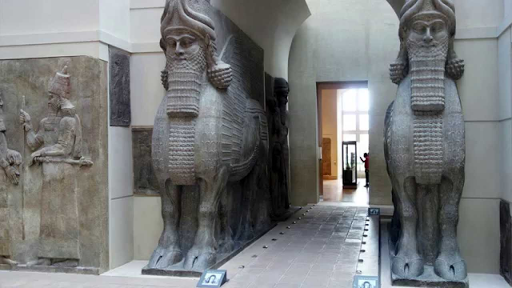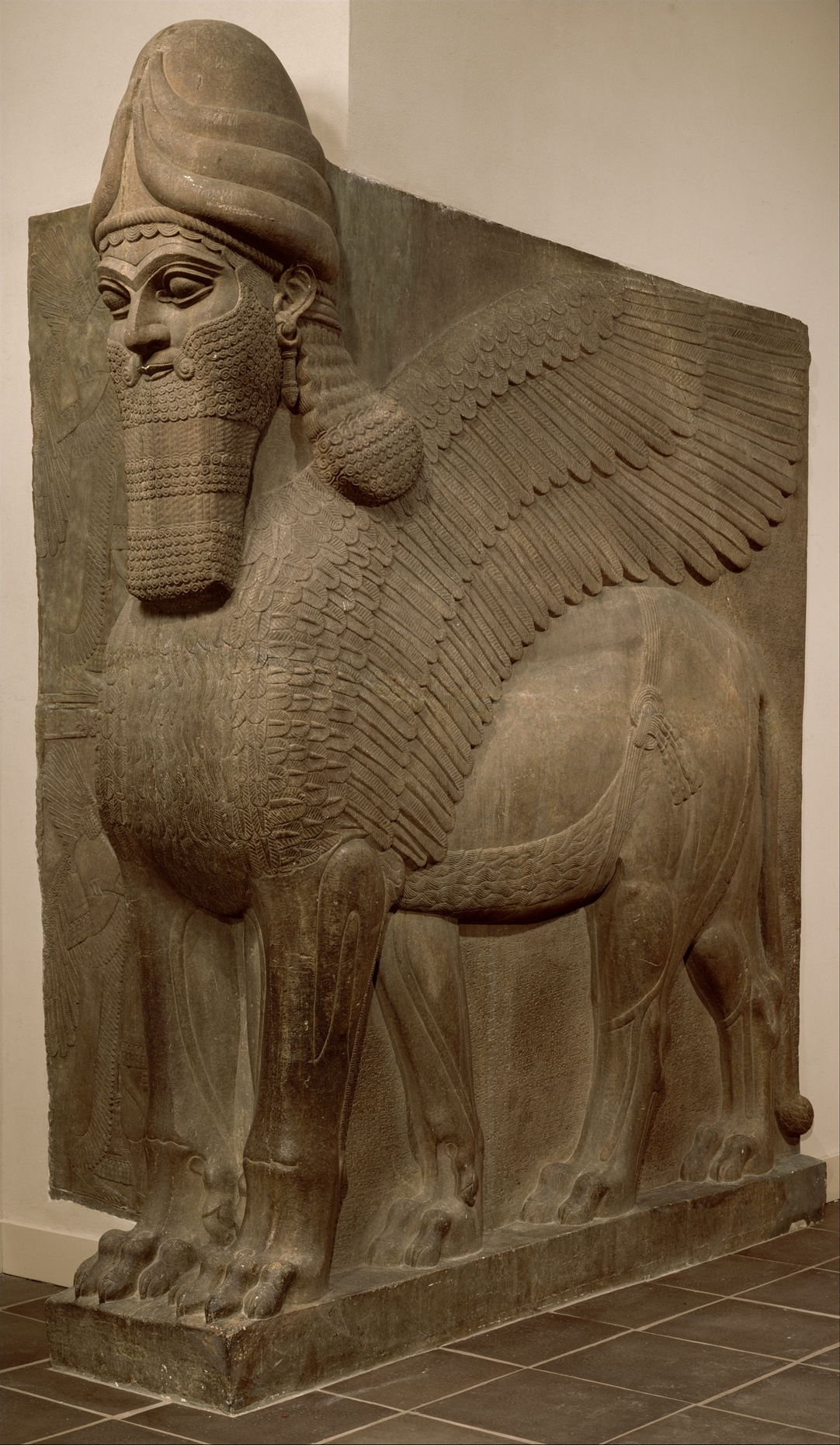The Lamassu sculptures were recovered from where. The Ziggurat at Ur was a fortress funerary monument palace temple platform Where were the Lamassu sculptures originally displayed.

Lamassu From The Citadel Of Sargon Ii Video Khan Academy
For this reason it is not an entirely freestanding sculpture.

. Originally unearthed in Rome and displayed in the Borghese Gallery it was sold to the occupying French and now sits in the Louvre. In the Assyrian mythology there were human headed winged bullslions that were protective genies. From what we can tell it seems that these sculptures were believed to protect the palace and king from evil supernatural forces as well.
Looking up the lamassu that have been displayed in the. What color is lapis lazuli. Who is the winged bull.
The Ziggurat at Ur was a fortress funerary monument palace temple platform Where were the Lamassu sculptures originally displayed. Lamassu were placed on either side of the doorways of Assyrian palaces and of gateways to cities to protect against evil spirits and impress the neighbors. However it is displayed in a museum in its original context a lamassu is the guardian of a doorway integral with a wall.
Colossal Lamassu Sculpture From The Palace Of Sargon Ii At Khorsabad Sargon Ii Google Arts Culture Human Headed Winged Bull Lamassu Assyrian Neo Assyrian The Metropolitan Museum Of Art Share this post. Appreciating and understanding ancient Egyptian art. The British Museum was the first public national museum in the world.
Originally unearthed in Rome and displayed in the Borghese Gallery it was sold to the occupying French and now sits in the Louvre. 721-705 BCE Part of a collection at the Louvre in Paris France. The lamassu of Ashurnasirpals Northwest palace were enormous stone-carved sculptures with the head of a human and displayed animal-like features including the wings of a bird and the body of a bull.
The most famous colossal statues of Lamassu have been excavated at the sites of the Assyrian capitals created by King Assurnasirpal II reigned 883 859 BC and King Sargon II reigned 721 705 BC. The Assyrians came first. This winged-bull known as a lamassu from textual sources was given to the OI by the Department of Antiquities in Iraq.
Where were the lamassu sculptures originally displayed. Which work has a king approaching the god Shamash. The gate and its lamassu were first excavated by Sir Austen Henry Layard in 1849 but then re-buried.
Assyrian sculpture typically placed prominent pairs of lamassu at entrances in palaces facing the street and also internal courtyards. The most famous colossal statues of Lamassu have been excavated at the sites of the Assyrian capitals established by King Assurnasirpal II reigned 883 859 BCE and King Sargon II reigned 721 705 BCE. In some cases the lamassu statues were accompanied by.
The first change was the capital was moved to Dur Sharrukin present day Khorsabad and second the Lamassu was presented on a bulls body compared to a lions and seems to be slightly smiling. And the lamassu which were thought of as protective deities stood guard either side of an entrance way. Lamassu the were.
What ethnic group is credited with the first system of writing known to man. The palace stood pairs of powerful mythological creatures known as lamassu Gates 170-171. Hermaphroditus was actually a popular subject of paintings and statuary even if Written By whitehouse March 11 2022 Add Comment Edit.
It documents the story of human culture from its beginnings to the present. The Assyrian sculpture was discovered in northern Iraq when archaeologists from the OI including Edward Chiera were excavating at Khorsabad Dur-Sharrukin in 1929. What ethnic group is credited with the first system of writing known to man.
The Assyrians envisioned a protective spirit that was part bull and part human and sometimes part eagle. What were the most common themes in Assyrian art. The Lamassu sculptures were recovered from where.
The winged beasts from Nimrud in Iraq the ancient city of Kalhu also became quite famous when Lamassu there were ruined in 2015. Ashurnasirpal Essay 1619 Words 7 Pages. An American professor named Michael Rakowitz was commissioned to recreate this Lamassu sculpture and it is now displayed in Trafalgar Square in London.
The Lamassu seen from the side from the palace Sargon II r. These massive sculptures served as symbolic guards of Assyrian kings domain being placed at the entrance to both the city and palace gateways See Collins 2008 72. It appears frequently in Mesopotamian artThe lamassu and shedu were household protective spirits of the common Assyrian people becoming associated later as royal protectors and were placed as sentinels.
Click to see full answer Furthermore where were the lamassu sculptures originally displayed. Which work has a king approaching the god. Originally unearthed in Rome and displayed in the Borghese Gallery it was sold to the occupying French and now sits in the Louvre.
They were represented as double-aspect figures on corners in high relief. The Ziggurat at Ur was a fortress funerary monument palace temple platform Where were the Lamassu sculptures originally displayed. The first change was the capital was moved to Dur Sharrukin present day Khorsabad and second the Lamassu was presented on a bulls body compared to a lions and seems to be slightly smiling.
This replica was made with 10000 Iraqi date syrup cans and serves as a symbol of. The lamassu is a celestial being from ancient Mesopotamian religion bearing a human head bulls body sometimes with the horns and the ears of a bull and wings. You can see them at Gate of All Nations at Persepolis in Iran the British Museum in London the Louvre in Paris the National Museum of Iraq in Baghdad the Metropolitan Museum of Art in New York and the University of Chicago Oriental Institute.
Human Headed Winged Bull Lamassu Assyrian Neo Assyrian The Metropolitan Museum Of Art

Lamassus At The Louvre Thatmuse

16 Lamassu Ideas Mesopotamia Ancient Near East Ancient Mesopotamia

Lamassu From The Citadel Of Sargon Ii Video Khan Academy

25 Lamassu From The Citadel Of Sargon Ii Dur Sharrukin Modern Iraq Ap Art History

Human Headed Winged Lion Lamassu Assyrian Neo Assyrian The Metropolitan Museum Of Art

Lamassu Backstory Article Assyrian Khan Academy
Colossal Lamassu Sculpture From The Palace Of Sargon Ii At Khorsabad Sargon Ii Google Arts Culture
0 comments
Post a Comment